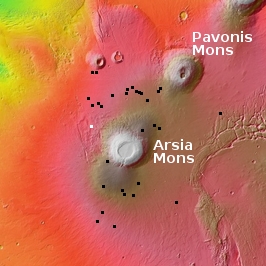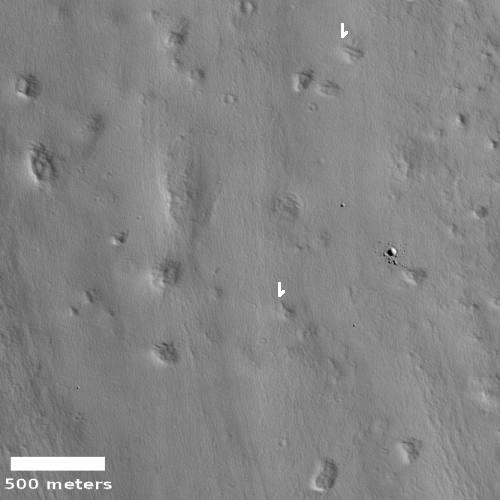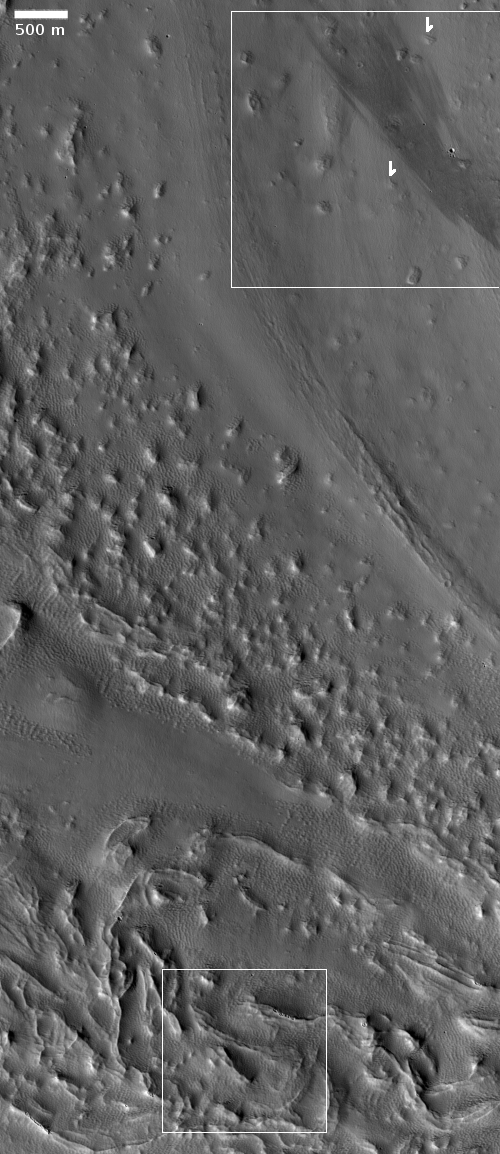More weird features and changes on Mars

Cool image time! The photo to the right, rotated, cropped, reduced, and annotated to post here, was taken on September 28, 2020 by the high resolution camera on Mars Reconnaissance Orbiter (MRO). Uncaptioned and labeled “Reticulate Bedform Change Detection on Arsia Mons West Flank,” it shows a whole bunch of strange features in addition to a change that occurred sometime in the past two years.
I think it also well illustrates in one image how alien Mars is.
The main features in this photo are what scientists have dubbed reticulate bedforms. These features, found mostly in the high elevations on the flanks of the giant volcanoes in the Tharsis Bulge to the west of Valles Marineris, are thought to be ancient dunes made of volcanic dust and debris that has solidified into an aggregate. These dunes are found with a variety of patterns.
Aggregates on the flanks are transported downslope by katabatic winds and form linear and “accordion” morphologies. Materials within the calderas and other depressions remain trapped and are subjected to multidirectional winds, forming an interlinked “honeycomb” texture. In many places on and near the volcanoes, light-toned, low thermal inertia yardangs and indurated surfaces are present.
The photo to the right appears to show all three patterns, even though it is located on the northwestern slopes of of Arsia Mons, the southernmost of the string of three giant volcanoes in the Tharsis Bulge. On the overview map to the right, this photo’s location is indicated by the white box. The black boxes indicate the location of all the pits caves that surround Arsia Mons which I have previously posted about on Behind the Black.
It is intriguing that, at least at this point, these particular reticulate bedforms on the slopes of Arsia Mons happen to be in a region where few cave pits have so far been identified. It could be that the conditions that form each are mutually exclusive. If you get pits on the slopes of Martian volcano you can’t have reticulate bedforms. Or maybe not all the pits have yet been located, or the flanks of the volcano has many more reticulate bedforms that I simply have not documented.
Either way, this particular cool image has two areas of interest, as noted by the white boxes above.

Click for full October 2018 photo.
The first, near the top, highlights the detected change that occurred sometime in the past two Earth years. The arrows in the 2020 photo above point to the same two distinct mounds in the 2018 photo to the right. Between these mounts a large dark slope streak has appeared.
As I have previously described, slope streaks are a unique phenomenon of Mars that remain unexplained. Though they look like avalanches, they do nothing to change the topography and show no evidence of material falling downslope. Instead, they appear to be a stain that suddenly moves downward, triggered it appears by some disturbance at the top, such as a rockfall.
The second photo to the right focuses in on the larger reticulate bedforms near the bottom of the first image. Not only do they not appear to follow any pattern, one ridge has some distinct holes at its peak. On Earth such holes could be created in hardened sand when rain hits it. The sand is easily washed away, and can form pits.
There is no rain on Mars. Why this particular ridge has that collection of holes is therefore a mystery.
But then, the slope streak to the north is a mystery as well. As I concluded in my first slope streak post,
The bottom line, as noted in one paper, “The processes that form slope streaks remain obscure. No proposed mechanism readily accounts for all of their observed characteristics and peculiarities.”
Mars is strange. Mars is alien. Mars epitomizes the universe in all its glory.
That last line applies to almost everything we see on Mars, not just its slope streaks.
On Christmas Eve 1968 three Americans became the first humans to visit another world. What they did to celebrate was unexpected and profound, and will be remembered throughout all human history. Genesis: the Story of Apollo 8, Robert Zimmerman's classic history of humanity's first journey to another world, tells that story, and it is now available as both an ebook and an audiobook, both with a foreword by Valerie Anders and a new introduction by Robert Zimmerman.
The print edition can be purchased at Amazon or from any other book seller. If you want an autographed copy the price is $60 for the hardback and $45 for the paperback, plus $8 shipping for each. Go here for purchasing details. The ebook is available everywhere for $5.99 (before discount) at amazon, or direct from my ebook publisher, ebookit. If you buy it from ebookit you don't support the big tech companies and the author gets a bigger cut much sooner.
The audiobook is also available at all these vendors, and is also free with a 30-day trial membership to Audible.
"Not simply about one mission, [Genesis] is also the history of America's quest for the moon... Zimmerman has done a masterful job of tying disparate events together into a solid account of one of America's greatest human triumphs."--San Antonio Express-News




I love looking over these Mars pictures.
Some of my observations;
The dark streaks in the first picture have impact crater anomalies that “block” the flow of darkness (streak wetness?) appearing like “Pitts” outgassing below the holes. (I see two nearly flat impact holes that look like shotgun splatter. Unusual)
In the more recent picture where slope streaks are gone, I could only find one streak on the edge of the picture between the two lava flows. You have to zoom in because it’s not very big, but it is dark.
I wonder if under ground fluid, frozen, rising to the surface during a warm day. Enough to make it wet, but not enough to cause erosion. it reminds me of fine oil, that evaporates not leaving a residue.
I doubt that it’s water, water dissolves minerals and would leave it as a crust, that appears white on the surface.
The pits at the top of the frozen dune appears at least a dozen times in the original picture. Another extreme case, as the one that is pictured, appears in the lower left.
I believe your descriptions are correct, a hardened surface being eaten away so the loose sand beneath can blow away. Looking at the other Sand dunes in area… what would’ve been their pointed tops are collapsed inwards forming valleys at the tops of most of the dunes. They collapsed ages ago and no longer look dramatic as the ones that catch your eye.